Introduction
Education is undergoing unprecedented disruption with rising costs, unequal access, and mounting expectations for personalized experiences. AI is emerging as the cornerstone of this transformation, enabling smart tutoring, predictive analytics, and operational efficiency. This guide explores real-world applications, measurable benefits, and the challenges that leaders must navigate.
What is AI and Why Does It Matter in Edtech?

Definition of AI and Its Core Technologies
Artificial Intelligence refers to computer systems engineered to mimic human cognitive functions such as learning, reasoning, and decision-making. These systems rely on advanced technologies like machine learning, natural language processing, and computer vision to interpret data and generate responses. AI applications are increasingly sophisticated, capable of handling tasks once thought to require uniquely human skills.
In the Edtech sector, AI is being used to personalize learning, automate repetitive tasks, and support educators with data-driven insights. These tools adapt in real-time to a learner’s performance, offering tailored content that improves engagement and outcomes. By streamlining administrative processes and enhancing instructional quality, AI is becoming integral to modern educational ecosystems.
The Growing Role of AI in Transforming Edtech
AI is redefining student engagement by personalizing instruction based on individual performance data. Adaptive learning platforms respond in real time, guiding students toward areas that need reinforcement. This tailored approach enhances learning outcomes and supports sustained academic growth.
Educational institutions are increasingly relying on AI-powered assistants to manage student inquiries and administrative tasks. These systems provide timely support for course planning and admissions, improving efficiency and service quality. By extending support capabilities without expanding staff, schools enhance their operational reach.
Teachers are leveraging AI-driven analytics to monitor student progress and identify risks early. These insights enable timely interventions and more responsive instructional strategies. As data becomes more actionable, educators can make informed decisions that directly impact student success.
For a broader perspective on how technology is reshaping learning environments, explore our analysis of the EdTech revolution and its emerging challenges.
Key Statistics and Trends Highlighting AI Adoption in Edtech
AI adoption in education is accelerating rapidly. The global AI in EdTech market was valued at $5.88 billion in 2024 and is expected to reach $8.30 billion in 2025, with a CAGR of over 31% through 2030. Another projection estimates growth to $98.1 billion by 2034, indicating a CAGR of 38.3%.
Usage among educators is growing significantly. In 2024, 51% of K–12 teachers and 45% of college faculty reported using AI tools, nearly doubling from the previous year. Among students, 86% now use AI in their studies, with over half using it weekly.
Higher education is also increasing internal adoption. A 2024 survey found 84% of higher-ed professionals use AI personally or professionally, up from 52% in 2023. Training and governance remain uneven, particularly in underfunded districts.
Business Benefits of AI in Edtech
AI is driving measurable improvements across the educational ecosystem, from instruction and assessment to operations and student support. These benefits translate into greater efficiency, personalized learning experiences, and stronger institutional performance.

1. Adaptive Learning
AI tailors learning experiences by analyzing each student’s progress and adjusting content in real time. Platforms like DreamBox and Century Tech adapt lessons to individual pace and comprehension, helping close learning gaps and keep students engaged. This level of personalization supports stronger academic outcomes across a wide range of learners.
For educators, adaptive tools reduce the need for generalized lesson plans and enable more targeted support. AI highlights where students are struggling, allowing teachers to intervene early and effectively. The result is a more responsive and efficient teaching environment.
2. 24/7 Academic Support
AI-powered assistants provide 24/7 academic and administrative help, from answering questions to guiding course registration. These tools reduce delays, improve accessibility, and ease the workload on support teams. Institutions benefit from faster service delivery without expanding headcount.
Students get timely assistance whenever they need it, especially during high-demand periods like enrollment. This enhances their overall experience and increases satisfaction. With AI, schools can scale support while maintaining quality.
3. Automated Grading and Feedback
AI streamlines the grading process for assignments, quizzes, and short written responses, saving teachers valuable time. Students receive instant feedback, which helps them learn and adjust quickly. This improves both the pace and quality of instruction.
Teachers can focus on deeper learning activities like discussions and project guidance. Automated systems also ensure consistency and reduce grading bias. Over time, this leads to more transparent and fair evaluation practices.
4. Predictive Insights
AI analyzes student behavior and performance to flag risks like disengagement or potential dropout. These insights help schools act early, whether by adjusting coursework or offering targeted support. As a result, institutions can improve retention and student success.
Leaders can also use these insights to allocate resources more effectively. Decisions around class sizes, tutoring, and scheduling become data-driven rather than reactive. This strengthens both academic and operational performance.
5. Teacher Enablement
AI assists educators with tasks like lesson planning, content recommendations, and performance summaries. This allows teachers to spend more time on instruction and student engagement. The added efficiency improves both morale and teaching quality.
Professional development platforms powered by AI also offer personalized training paths based on a teacher’s strengths and gaps. Programs like Microsoft’s and OpenAI’s teacher training hubs are helping to close the skills gap. These initiatives build long-term institutional readiness and confidence in AI integration.
Challenges Facing AI Adoption in Edtech
Despite its promise, AI adoption in education is not without significant hurdles. Schools must navigate data risks, equity concerns, and evolving ethical standards to implement AI effectively and responsibly.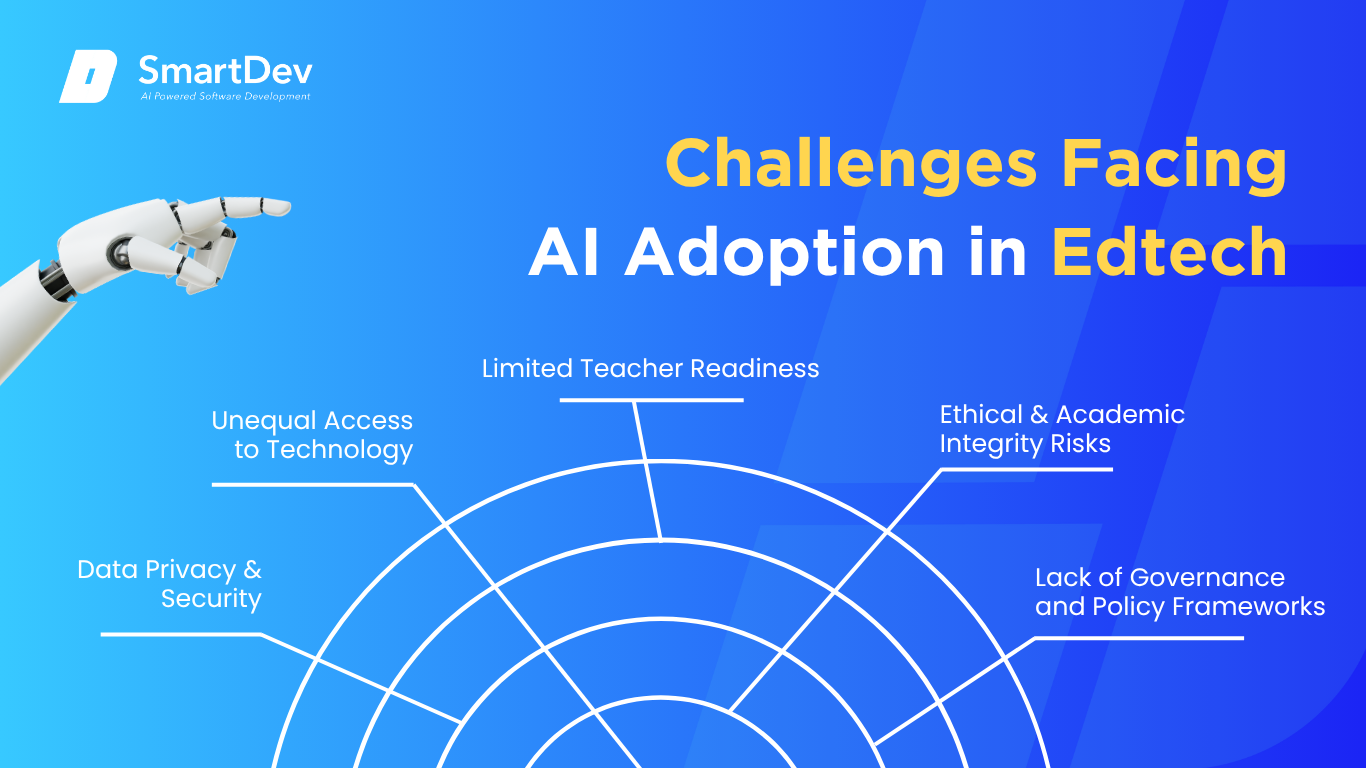
1. Data Privacy and Security
AI systems in education require large volumes of student data to function effectively, raising significant concerns about privacy and data protection. Without clear safeguards, institutions risk exposing sensitive information to misuse or breaches. These concerns are heightened by varying global standards and limited regulatory clarity around student data.
To earn trust, schools must adopt transparent data practices and comply with standards like FERPA or GDPR. This includes implementing secure data storage, access controls, and clear consent mechanisms. Without these foundations, AI tools may face resistance from parents, educators, and administrators alike.
Similar to fintech, educational institutions face increasing pressure to comply with global data regulations. Learn how other sectors are navigating data compliance in the digital era.
2. Unequal Access to Technology
Access to AI tools is uneven, often reflecting broader digital divides between well-funded and under-resourced institutions. Schools in low-income or rural areas may lack the infrastructure, internet bandwidth, or device availability needed to implement AI effectively. This threatens to widen educational inequality instead of reducing it.
Bridging this gap requires strategic investment in technology access, teacher training, and infrastructure upgrades. Without targeted funding or policy intervention, AI could become yet another advantage held by elite institutions. Ensuring broad access is key to realizing AI’s full potential in education.
3. Limited Teacher Readiness
Many educators are unfamiliar with how AI works or how to integrate it meaningfully into instruction. A lack of formal training and support leads to underuse or misuse of AI tools in the classroom. This creates a gap between what technology can offer and how it is actually applied.
To address this, institutions must invest in ongoing professional development tailored to educators’ needs. Programs like those supported by Microsoft and OpenAI are steps in the right direction but need broader adoption. Equipping teachers with both technical and pedagogical knowledge is essential for sustainable AI integration.
4. Ethical and Academic Integrity Risks
AI tools can be misused by students to complete assignments or exams, raising serious concerns about plagiarism and academic dishonesty. Educators are still developing standards to distinguish between appropriate AI assistance and unethical shortcuts. This ambiguity can undermine trust in assessments and learning outcomes.
Schools need clear policies that define acceptable AI use and promote responsible student behavior. Assignments may also need to evolve, emphasizing process and reasoning over final answers. Without these adjustments, AI could unintentionally erode critical thinking and academic rigor.
5. Lack of Governance and Policy Frameworks
Many institutions are implementing AI tools without a clear governance structure in place. This leads to inconsistent use, potential legal exposure, and challenges in aligning AI tools with broader educational goals. Policies often lag behind actual classroom adoption.
A formal governance framework should outline ethical guidelines, procurement standards, and accountability structures. Only with these foundations can schools scale AI in a way that is strategic, equitable, and sustainable. Governance is no longer optional, it is a prerequisite for responsible innovation.
Specific Applications of AI in Edtech
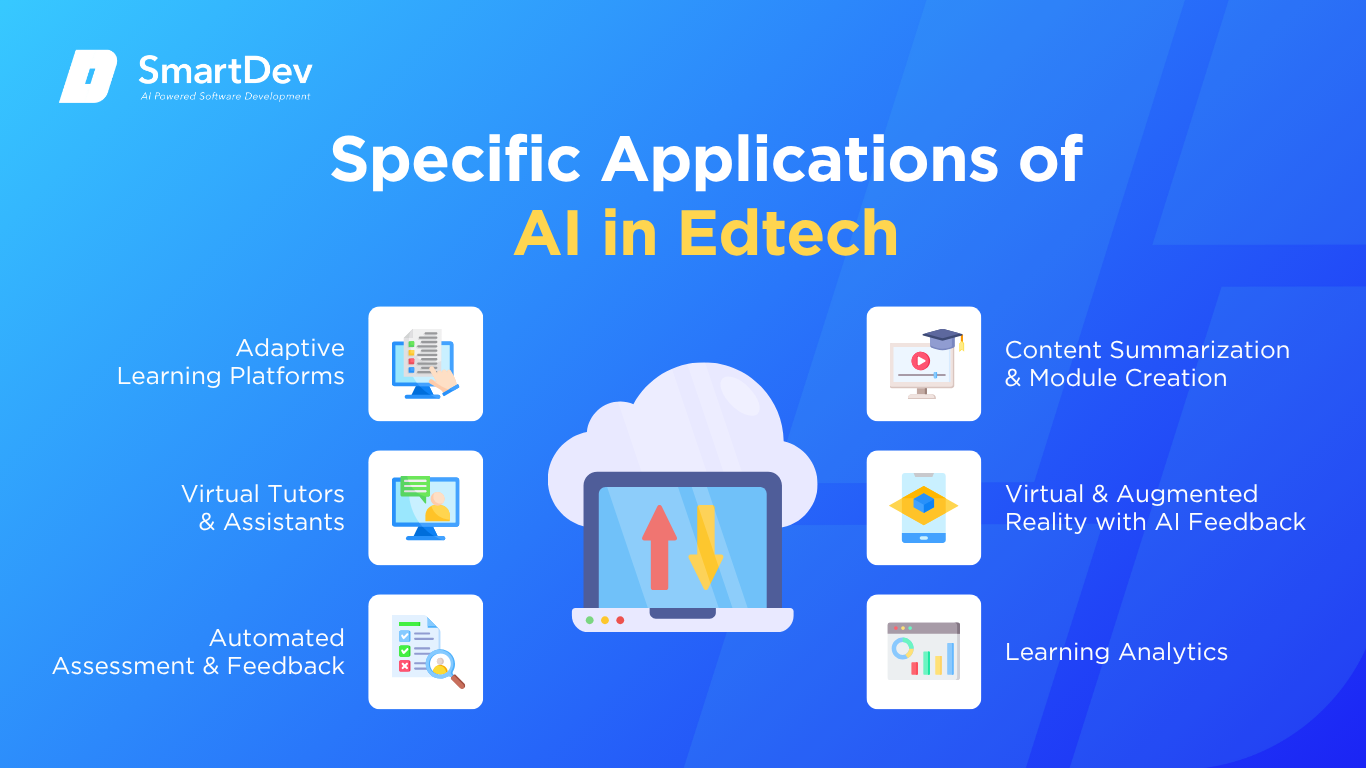
1. Adaptive Learning Platforms
AI-driven adaptive learning platforms customize lessons based on each student’s knowledge gaps and learning pace. These systems analyze user data – correct/wrong answers, timing, engagement – to dynamically adjust content difficulty and sequencing. They integrate into classroom and online environments, offering personalized learning paths at scale.
Adaptive learning enhances learning efficiency by targeting weak spots, reducing time spent on mastered topics, and improving motivation. However, ethical considerations include data privacy, algorithmic bias, and maintaining transparency of decision logic. It empowers educators to scale individualized instruction without manually tracking every learner.
These systems leverage algorithms like decision trees, neural networks, and Bayesian models. They require continuous streams of learner performance data and connect via APIs to LMS platforms. Teachers can monitor real-time dashboards and intervene when students show signs of disengagement or struggle.
Real-world example:
Squirrel AI, a pioneering Chinese edtech company, implements an Intelligent Adaptive Learning System that deconstructs curriculum into over 10,000 granular knowledge points. This system generates personalized learning paths based on diagnostic testing and real-time performance tracking. Operating in more than 2,000 learning centers across China, Squirrel AI has improved student achievement by dynamically addressing gaps in understanding.
2. AI-Powered Virtual Tutors & Assistants
AI tutors mimic human tutoring by engaging in Q&A, Socratic questioning, and on-demand guidance. They employ NLP and LLMs to interpret student queries – including freeform or voice input – and generate context-aware responses. Often integrated via chatbots or voice interfaces, they support in-class and remote learning systems.
These tutors boost engagement, offer instant feedback, and support scalable personalized instruction. Key concerns include controlling potential over-reliance, ensuring answer accuracy, and protecting sensitive student information. Strategically, they close the 1:1 tutoring gap for millions without access to personal tutors.
Their core technologies include transformer-based language models, semantic search engines, and custom knowledge bases. Some also integrate with voice synthesis and speech recognition for accessibility. The tools evolve via feedback loops based on learner input and teacher corrections.
Real-world example:
Khanmigo, an AI-powered virtual tutor developed by Khan Academy using OpenAI’s GPT, provides personalized learning support for students and classroom assistance for teachers. Piloted in over 266 U.S. school districts, it features tools for Socratic dialogue, coding help, and lesson planning. Khan Academy aims to improve student outcomes by up to 30% and has received a 4-star rating from Common Sense Media for educational transparency and safety.
3. Automated Assessment & Feedback
AI-driven assessment tools grade essays, projects, and problem sets by analyzing grammar, structure, originality, and subject accuracy. They leverage machine learning models trained on educator-graded exemplars and integrate into LMS to deliver rapid feedback. These tools are scalable across thousands of assignments.
This application reduces teacher workload, offers students timely insights, and supports formative assessment cycles. Risks include the possibility of false positives in plagiarism checks and fairness across language backgrounds. Tools often offer human-in-the-loop options to ensure quality assurance.
The underlying models include text classification, topic modeling, and coherence scoring systems. AI learns from rubrics and teacher input, refining its grading criteria over time. Advanced platforms also provide recommendations for student improvement.
Real-world example:
QANDA, developed by Mathpresso, uses optical character recognition (OCR) and its proprietary MathGPT to analyze and solve math problems. Available in 50 countries, it serves 8 million monthly active users and has processed over 6.3 billion math-related queries. The platform significantly improves problem-solving skills by offering step-by-step solutions in real time.
4. Intelligent Content Summarization & Module Creation
AI summarization tools extract key concepts and generate concise overviews from textbooks or lectures. They utilize NLP for text summarization and knowledge extraction, then structure content into flashcards or video scripts. Integration occurs within e-readers, LMS, and instructor dashboards.
This technology enhances student retention and streamlines lesson creation for educators. Risks include potential misrepresentation of content and dependency on AI-generated summaries. Nonetheless, they save teachers significant prep time while aligning to curriculum standards.
Summarization systems use transformer-based models (e.g., BART, T5), extractive and abstractive summarization pipelines, and domain-adapted datasets. Some platforms use reinforcement learning to optimize output quality based on teacher ratings.
Real-world example:
Snapplify, a prominent edtech platform across Africa and beyond, offers Book Buddy – an AI-driven assistant that summarizes textbooks and provides personalized content recommendations. It supports students with learning guides, assessment tools, and summaries embedded directly into its digital library system. The tool is widely adopted in South Africa, Kenya, and Nigeria, supporting literacy and study skills at scale.
5. Virtual & Augmented Reality with AI Feedback
AI-enabled VR/AR training simulates real-world environments—laboratories, language immersion, or vocational skills. They rely on computer vision and AI analytics to track learner actions, then deliver adaptive feedback. These are embedded into specialized platforms and institutional training curriculums.
Such immersive experiences build deeper learning, increase retention, and allow safe practice of complex tasks. Barrier issues include cost, scalability, hardware accessibility, and motion-sickness considerations. Still, they redefine experiential learning in a digital context.
These systems fuse computer vision, AI analytics, spatial mapping, and behavior recognition. Learner interactions are recorded, and AI generates individualized reports on performance and improvement areas.
Real-world example:
Virti, a UK-based company, offers immersive VR simulations for medical and soft skills training, supported by AI performance analytics. Adopted by the UK National Health Service (NHS) and U.S. hospitals, the platform tracks learner decisions during simulated crises. It has shown to improve knowledge retention by 230% and enhance communication skills significantly.
6. Learning Analytics & Predictive Retention Models
AI analytics platforms process learner interactions (time spent, submission patterns, error rates) to detect risk signals. Using ML classification and clustering, they predict drop-out risk or low engagement and issue alerts or suggested interventions. These tools plug into LMS dashboards for educators and admins.
This application enhances learner success through early intervention and data-driven insights. Ethical considerations involve sensitive data usage and bias in predictive models. When implemented well, it helps educators act proactively rather than reactively.
Technically, these systems use algorithms like random forests, logistic regression, and clustering. Data pipelines ingest LMS activity logs, demographic info, and performance scores to train risk classifiers. Dashboards visualize risk heatmaps and suggested support actions.
Real-world example:
Kira Learning, co-founded by AI expert Andrew Ng, uses intelligent agents to help teachers with grading, feedback, and identifying struggling students. Piloted in Tennessee and expanding to other U.S. states, it integrates into computer science curricula. Kira’s tools help reduce teacher workload and personalize learning interventions for students at risk of falling behind.
Need Expert Help Turning Ideas Into Scalable Products?
Partner with SmartDev to accelerate your software development journey — from MVPs to enterprise systems.
Book a free consultation with our tech experts today.
Let’s Build TogetherExamples of AI in Drug Discovery
AI implementations in education are not limited to theory, they’re actively shaping student outcomes and classroom efficiency. The following real-world case studies demonstrate how leading platforms are applying AI to solve tangible challenges.
Real-World Case Studies
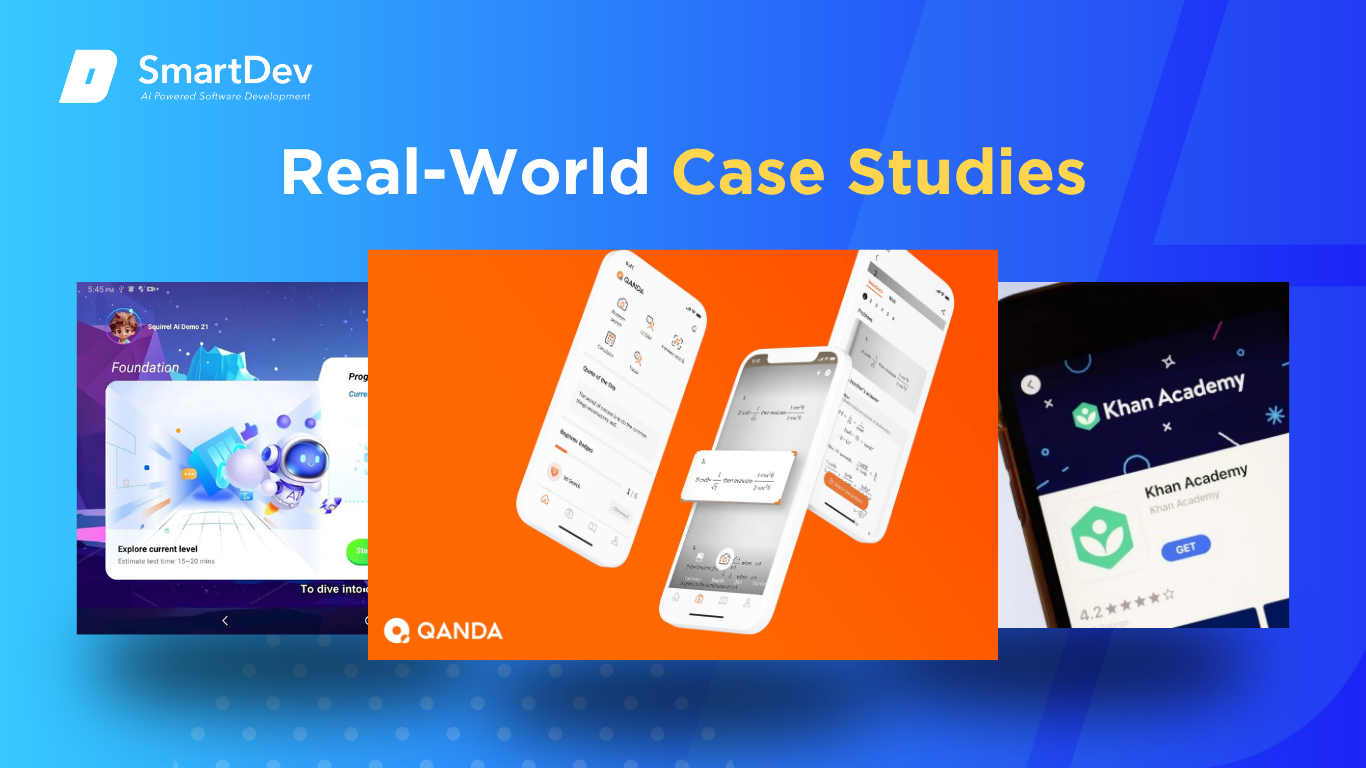
1. Khan Academy: Personalized Tutoring at Scale
Khan Academy introduced Khanmigo, an AI-powered tutor and teaching assistant based on OpenAI’s GPT, to deliver personalized guidance in classrooms. The platform supports Socratic dialogue, computer science help, and feedback tools for teachers, creating interactive, student-centered learning. Piloted across over 266 U.S. school districts, it helps reduce the educator workload while maintaining pedagogical rigor.
Khanmigo is designed to enhance academic outcomes by increasing personalized support in real time, and is free for teachers while offering a $44/year subscription for others. Common Sense Media awarded it four stars for its ethical transparency and safety in AI implementation. Teachers report that it fosters independent thinking and boosts student engagement.
2. Mathpresso: QANDA’s AI Math Solutions
QANDA by Mathpresso allows students to snap photos of math problems and receive step-by-step solutions through its MathGPT AI engine. Using OCR and deep learning, QANDA generates accurate responses while explaining methodology to enhance comprehension. It supports 8 million monthly users across 50+ countries, with significant usage in Vietnam, Japan, and South Korea.
To date, QANDA has processed more than 6.3 billion questions. It is praised for improving student confidence and reducing math anxiety through immediate, guided feedback. Its tools are accessible via mobile, making it a vital resource for self-learners and test preparation worldwide.
3. Squirrel AI: Nation-Scale Adaptive Learning
Squirrel AI delivers personalized learning paths using a granular, knowledge-point model tailored to each student’s strengths and weaknesses. The system adapts lesson sequences based on diagnostic tests and continuous performance feedback. It operates in over 2,000 centers across 200+ cities in China, representing one of the world’s most scaled AI tutoring deployments.
The platform has shown to significantly improve math and science outcomes, particularly in under-resourced regions. In 2020, it set a Guinness World Record for the largest AI-powered math lesson ever conducted. Squirrel AI’s use of real-time analytics makes it a model for adaptive education at national scale.
Innovative AI Solutions
Emerging AI technologies are advancing how education systems respond to learner needs, personalize instruction, and scale equity. One standout example is Google’s Read Along app, which uses speech recognition AI to help children improve their reading fluency by listening to them read aloud and offering real-time feedback. As of 2023, Read Along has served over 30 million children across more than 180 countries.
Another innovation comes from Duolingo’s AI-powered personalized pathways and Explain My Answer feature, driven by GPT-4. These tools help learners understand complex grammar in simple language and adapt lesson difficulty dynamically. The company has stated that these enhancements improved retention and learning outcomes, leading to an all-time high of 83.1 million monthly active users in Q1 2024.
To explore how gamification complements AI in boosting engagement and motivation, check out our guide to gamification in EdTech, including strategies and real-world examples.
AI-Driven Innovations Transforming Edtech
Emerging Technologies in AI for Edtech
AI is transforming education through systems that personalize learning and streamline tasks. Generative AI enables dynamic content tailored to each student’s needs, making learning more adaptive and engaging. These tools adjust in real time, enhancing both comprehension and retention.
Computer vision analyzes visual data like handwritten assignments and student engagement cues. It delivers insights that support faster, more accurate assessment and instruction. This reduces manual grading time and helps educators quickly identify learning gaps.
Explore how custom-built cross-platform solutions enhance interactive learning in our case study on powering immersive educational experiences.
AI’s Role in Sustainability Efforts
AI supports sustainability in education by optimizing how resources are used and reducing waste. Predictive analytics help institutions forecast enrollment, classroom needs, and material usage more accurately. This leads to smarter planning and less overproduction of educational resources.
Smart systems powered by AI also manage energy use on campuses more efficiently. They adjust lighting, heating, and cooling based on real-time occupancy and usage patterns. Over time, this reduces both environmental impact and operational costs.
How to Implement AI in Edtech
Implementing AI in EdTech isn’t just about adopting new tools, it’s about creating the right foundation for long-term success. From assessing readiness to training teams, each step plays a critical role in turning AI potential into measurable impact.
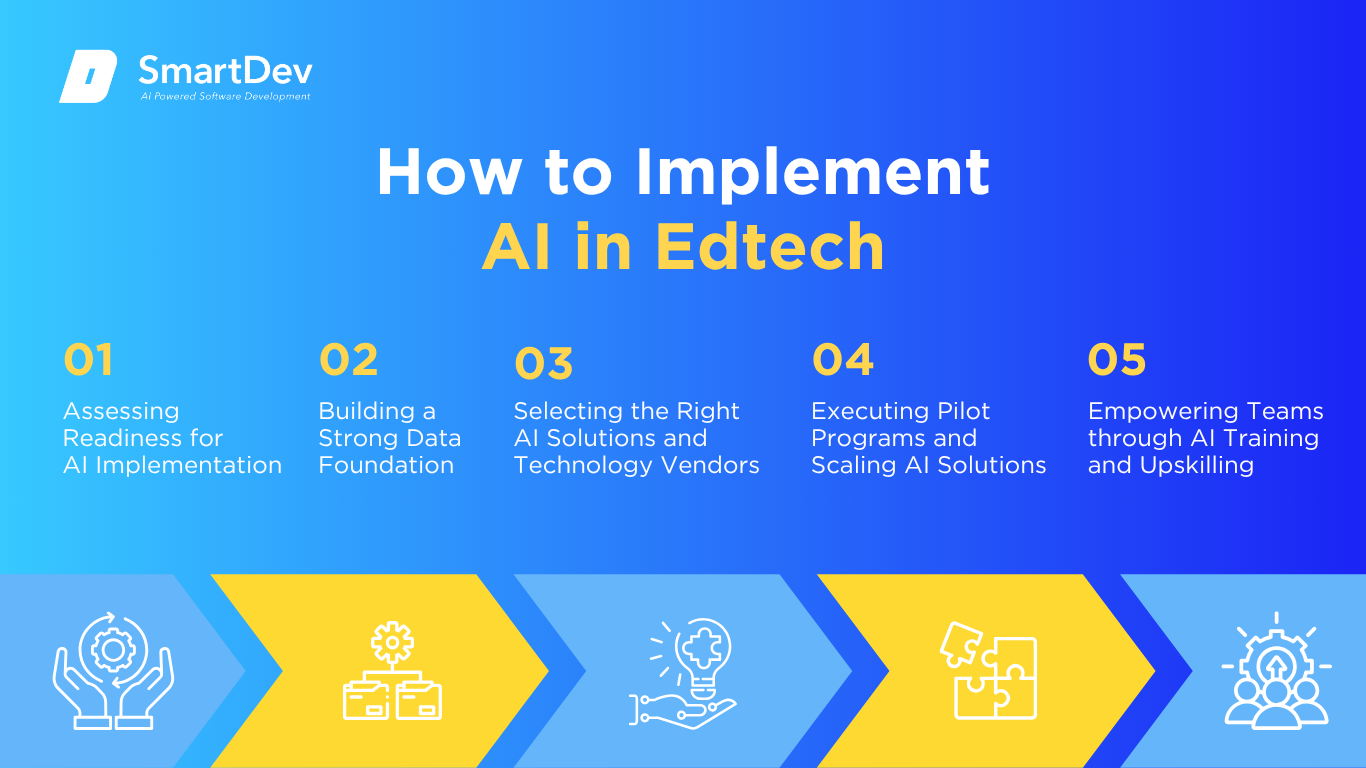
Step 1: Assessing Readiness for AI Adoption
Before bringing AI into the classroom or operations, assess your institution’s current digital capabilities. Look for areas that depend heavily on repetitive tasks – like grading, scheduling, or content delivery – as these are ideal entry points. Targeting these first ensures minimal disruption while delivering tangible improvements quickly.
You also need to evaluate whether your leadership and teaching staff are ready for change. AI adoption isn’t just a technical upgrade, it requires buy-in across academic and administrative levels. Without cultural readiness, even the best tools can underdeliver.
Step 2: Building a Strong Data Foundation
AI systems are only as effective as the data they’re built on. Schools and education providers need consistent, high-quality data from learning platforms, attendance logs, and student assessments. A clean, structured dataset forms the backbone of any intelligent application.
Centralizing this data helps different departments work from a single source of truth. It also ensures AI tools can generate accurate insights, supporting better decisions. Prioritize data governance and privacy compliance to maintain trust and regulatory standards.
For AI to work effectively in education, model performance must be continuously monitored and optimized. This guide to AI efficiency explores how to evaluate and improve model outputs.
Step 3: Choosing the Right Tools and Vendors
Picking the right AI partner goes beyond features. You want a solution that aligns with your educational objectives and integrates easily with your existing platforms. Whether you use a learning management system or a custom stack, compatibility is key.
Ask vendors how their tools handle sensitive data like student performance records. Transparency around data usage, model accuracy, and long-term support should be non-negotiable. A strong vendor relationship ensures your AI initiatives stay agile and relevant as needs evolve.
Step 4: Pilot Testing and Scaling Up
Start small by testing AI tools in a single class or department. Whether it’s automating quiz creation or tracking student progress, pilot projects help you uncover what works, and what doesn’t, before scaling up. These early tests also help you earn credibility with faculty and stakeholders.
After each pilot, review outcomes closely. Look at performance improvements, user feedback, and ease of use. If the impact is clear, it becomes much easier to roll out AI more broadly with confidence.
For a real-world example of how EdTech platforms can modernize legacy systems while integrating AI-driven features, read our case study on revitalizing legacy systems in education.
Step 5: Training Teams for Successful Implementation
Introducing AI isn’t just about the tech, it’s about the people using it. Teachers and staff need training to understand how AI supports instruction, enhances feedback, and reduces workload. Focus on building confidence, not just technical skill.
Encourage collaboration between tech leaders and educators during implementation. When everyone understands the purpose and potential of AI, adoption becomes smoother. A trained, informed team is the key to sustainable success with AI in education.
To ensure successful AI integration, institutions should start with a clear roadmap. Our guide for tech leads outlines how to assess readiness and align stakeholders from the start.
Measuring the ROI of AI in Edtech
Key Metrics to Track Success
ROI in EdTech isn’t just about cost, it’s about how AI improves learning and saves time. Teachers often reclaim several hours per week by automating grading and content prep, boosting instructional quality. Institutions benefit through more efficient operations and better allocation of staff resources.
Cost reductions also come from smarter planning and automation across support services. At the same time, success is measured in outcomes like improved grades, engagement, and retention. These gains show the long-term educational value of AI beyond immediate savings.
Case Studies Demonstrating ROI
At IU International University, an AI learning assistant cut student study time by 27% within three months. Students learned faster, while educators spent less time on repetitive support. The result was both improved academic outcomes and clearer value from technology use.
In Ghana, an AI tutor accessed via WhatsApp significantly raised math scores with minimal tech investment. With just two sessions per week, students saw measurable progress over eight months. It proved AI can drive strong returns even in low-resource settings.
Common Pitfalls and How to Avoid Them
Many schools adopt AI without clear goals or metrics, making it hard to prove value. Without tracking time savings or student impact, even useful tools may appear ineffective. Defining success early ensures AI stays aligned with core educational priorities.
Resistance from staff is another common barrier. Without training and buy-in, adoption stalls and value drops. Schools that support educators through change are more likely to unlock real, lasting ROI.
Future Trends of AI in Edtech
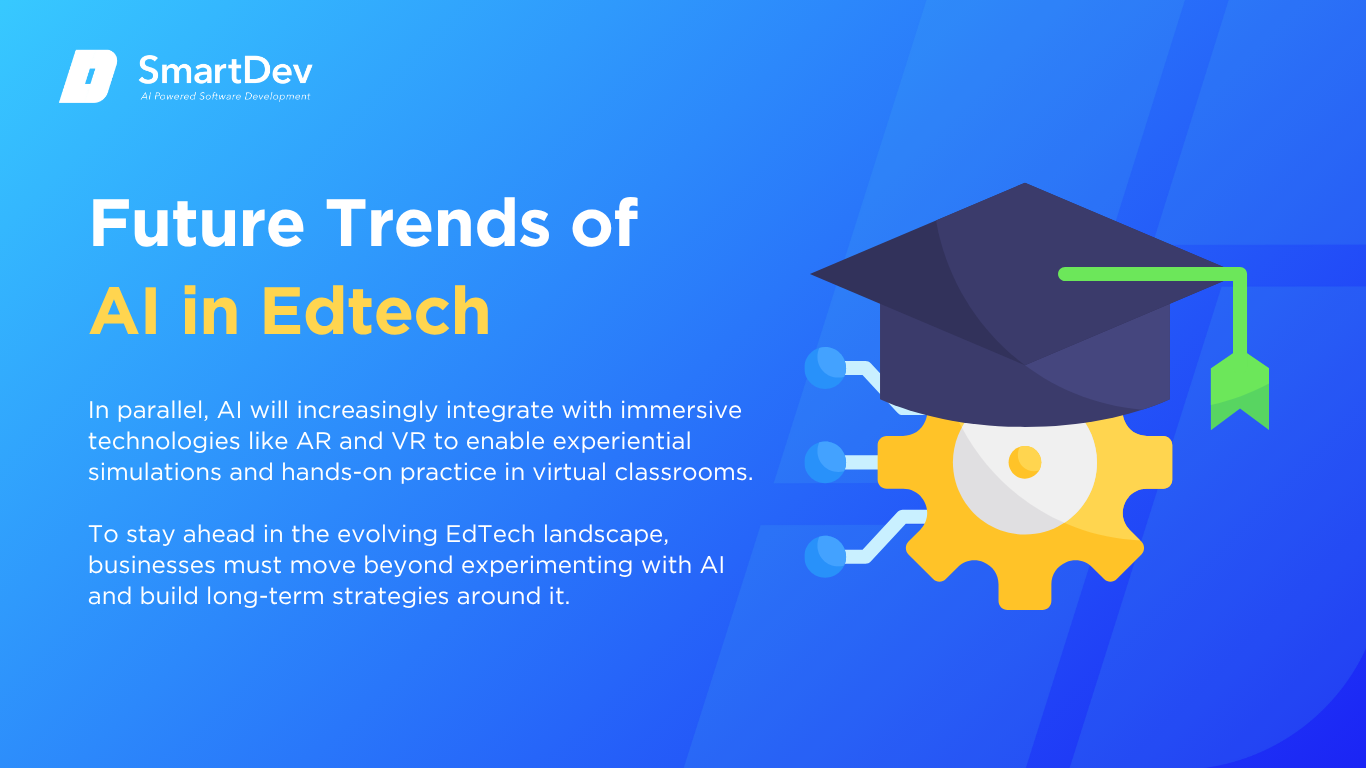
Predictions for the Next Decade
AI in EdTech is expected to grow rapidly, with the global market projected to reach $75.4 billion by 2033, up from $4.8 billion in 2024, driven by demand for personalized and scalable learning experiences. The next phase will feature generative AI tutors, real-time content adaptation, and emotionally intelligent feedback systems designed to meet learners where they are. These tools promise to make learning more engaging, efficient, and tailored to individual progress.
In parallel, AI will increasingly integrate with immersive technologies like AR and VR to enable experiential simulations and hands-on practice in virtual classrooms. Institutions that prioritize infrastructure, data readiness, and educator training will be better positioned to lead this shift. Staying competitive will also depend on forging partnerships with AI developers and committing to transparency, privacy, and equity in every phase of adoption.
How Businesses Can Stay Ahead of the Curve
To stay ahead in the evolving EdTech landscape, businesses must move beyond experimenting with AI and build long-term strategies around it. This starts with aligning AI adoption to clear educational goals, such as boosting engagement, reducing dropout rates, or scaling personalized instruction. Companies that tie their innovation efforts to real learner outcomes are more likely to gain trust and traction in a crowded market.
Keeping pace also means investing in adaptable infrastructure and building partnerships with schools, educators, and research institutions. Staying close to the classroom ensures tools are relevant, ethical, and easy to integrate into daily learning. By focusing on impact, transparency, and continuous feedback, EdTech companies can lead the next phase of intelligent, student-centered education.
Conclusion
Key Takeaways
AI is transforming education by personalizing learning, streamlining tasks, and enhancing outcomes for both students and educators. Tools like generative AI and intelligent tutoring systems are making learning more adaptive and teaching more efficient. Institutions that leverage these technologies are seeing real gains in engagement, performance, and operational efficiency.
The key to success lies in careful planning: assessing readiness, ensuring quality data, and selecting the right partners. When done right, AI delivers clear ROI and positions schools to thrive in a more digital, learner-centered future.
Moving Forward: A Strategic Approach to AI-Driven Transformation
As AI continues to transform the educational landscape, now is the time to rethink how your institution delivers learning, manages operations, and supports student success. From automating repetitive tasks to delivering personalized learning at scale, AI is not just a trend, it’s a critical driver of competitive advantage in modern education.
At SmartDev, we build custom AI solutions tailored to the unique needs of EdTech providers, academic institutions, and training organizations. Whether you’re looking to improve engagement, streamline administrative workflows, or unlock real-time student insights, we help you design and deploy tools that deliver measurable results.
Discover how SmartDev’s custom EdTech solutions can help you harness AI to personalize learning, boost efficiency, and drive meaningful outcomes.
Explore our AI-powered software development services to see how we enable personalized learning, predictive analytics, and intelligent automation that scales with your goals.
Contact us today to learn how AI can elevate your EdTech strategy and position your organization for lasting impact.
—
References:
- AI In Education Market Size & Share: Industry Report, 2030 | Grand View Research
- AI in EdTech Market By Deployment (Cloud and On-Premises), By Application, By End-User – Global Industry Outlook, Key Companies (Google, Microsoft, Amazon, and others), Trends and Forecast 2025-2034 | Dimension Market Research
- 2024 in Review: AI & Education | Cengage Group
- Survey: 86% of Students Already Use AI in Their Studies | Campus Technology
- Four Stars for Khanmigo: Common Sense Media Rates AI Tools for Learning | Khan Academy
- Will AI revolutionise education for the better? | Financial Times
- 6 EdTech AI trends: How artificial intelligence is reshaping education | Amazon Web Services
- The ROI of Educational Technology Tools: Reshaping Learning for a Smarter Future | Codebridge
- Revolutionising Distance Learning: A Comparative Study of Learning Progress with AI-Driven Tutoring | arXiv
- Effective and Scalable Math Support: Evidence on the Impact of an AI- Tutor on Math Achievement in Ghana | arXiv







